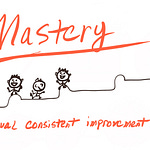After moving to Silicon Valley a few months ago from the Midwest and trying to break into "product," I became fascinated by what people actually mean when they say the word.
Product, production, produce.
When you look up the etymology of the word product, it breaks down from the original latin producere as pro, or roughly "before, forth" and ducere, or "to bring, to lead."
Putting these together we have something like product = to lead or bring forth into being or existence.
There's something deeply right about this IMHO. Ahh words.
From Atoms to Artisans
If you'd had asked me what products were all about for the vast majority of my time in the Midwest, I probably would've assumed the question related to atoms rather than bits. I think this is a Midwest thing, but maybe it's just a ignore-ant Greg thing, or a mechanical and materials engineer thing? It's not clear who's to blame for this.
Fundamentally, I would've thought you were talking about simply making stuff. And you probably would've been. But that doesn't mean that we would've been on the same wavelength. Quite literally, if you were thinking app store while I was careening down aisles of inventory in my mind, we would have been musing on applications operating on incredibly different wavelengths. So much stuff that we use today leverages technology that is and will forever remain invisible to us.
At this point I'm going to throw a much less sexy term into the mix: manufacturing.
I know, I know, your eyes are glazing over. Just stick with me for a second while we have our second round of ... word history! Manufacturing breaks down as roughly manu, or "hand" and factus, or "make." Hand-make, hand-craft. Who does this? Artists of course, or to borrow a slightly more antiquated term, artisans. You might call what makers on Etsy do when they handmake stuff artisanal production.
So making stuff, manufacturing stuff, and producing stuff, these are roughly the same? Well, yes, sort of. They're all roughly the same for atoms, in other words for stuff that we can hold in our hands. Physical stuff that we can see. In fact, manufacturing and production have been intrinsically linked for most of human history; that is, until the 21st century.
That’s worth saying again because it’s such a critical piece of our understanding of products and production.
Manufacturing and production have been intrinsically linked for most of human history, until now.
Stick with me, because this gets pretty meta in a hurry.
“Wait, Greg, so are you saying that while what people sell on Etsy are physical products, the entire Etsy marketplace itself, which empowers sellers to connect with buyers, is also made up of a suite of digital products?”
That’s right! And, in fact, the marketplace itself that allowed sellers to post their hand-made goods online and receive payment for them, was their first digital product. To this day, even though Etsy is a ginormous marketplace (also called a “platform” or “network platform” in today’s parlance), their first product remains their “core product” today. The difference is that today, there are tons of digital products that make up the Etsy platform.
Clear as mud, right?
Allow me a hardware analogy from the age of artisanal production. If I make 20 widgets an hour because I have 10 people who can each hand-craft two widgets per hour, then the product that I produce is the widget. Not the people, and not the useful work that they're putting in to convert raw materials to something of greater value.
In the same way, the digital product that allows sellers to actually post their goods to Etsy.com is the thing that people are paying for. Said differently, it’s the part of Etsy’s production system that creates value for the customer (who is, in this case, confusingly, also a seller, lol).
So where are the people and their useful work in this picture of digital products?
Fantastic question!
We need to travel a little further onward through history to get to the bottom of this in a simple, easy-to-understand way. Because in the vicinity of this very question is where Midwest manufacturing loses touch with Silicon Valley production.
In order to do better, we need to consider how things started changing, just a few hundred years ago, when artisanal production began to be outpaced by the next wave of innovation.
Then we’ll need to consider all of the crazy things that have happened since, leading up to today. We’ve got a long road to travel yet, and I never even include phygital or fungible products on the original chart I tweeted a few months back when I decided to set out on this adventure…📈👇
Artists Hand-Made Stuff for Most of History
And so this week we’ve gotten a feel for humanity’s first phase of products, production, and manufacturing; it starts with artisanal goods. Of course, designs still had to be conceptualized, prototyped, and iterated on, but this method of hand-crafting many items from one is what skilled professionals relied on to produce all of our stuff in the pre-industrial world.
When people were obviously more than just monkeys with hand tools, we were artists. Our methods, however, simply didn’t scale that well. And the quality problem, man, it was really hard to solve back then. Too many variables. Too many unknowns.
That’s why we didn’t start solving these problems until the next breakthrough, which we might nostalgically refer to as Industry 1.0, which is the topic of next week’s Unautomatablog.
By the end of January, I hope that you dear reader will understand products a little better, and at least have a bit more insight into why it’s impossible to Google “Etsy’s products” or “Etsy’s digital products” or “Etsy’s non-fungible products” and make heads or tails of when manufacturing and production were still intrinsically linked in the world, and when they weren’t.


















Share this post